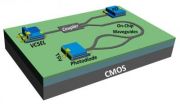(Press-News.org) WASHINGTON, May 29, 2014—A new twist on 3-D imaging technology could one day enable your self-driving car to spot a child in the street half a block away, let you answer your Smartphone from across the room with a wave of your hand, or play "virtual tennis" on your driveway.
The new system, developed by researchers at the University of California, Berkeley, can remotely sense objects across distances as long as 30 feet, 10 times farther than what could be done with comparable current low-power laser systems. With further development, the technology could be used to make smaller, cheaper 3-D imaging systems that offer exceptional range for potential use in self-driving cars, smartphones and interactive video games like Microsoft's Kinect, all without the need for big, bulky boxes of electronics or optics.
"While meter-level operating distance is adequate for many traditional metrology instruments, the sweet spot for emerging consumer and robotics applications is around 10 meters" or just over 30 feet, says UC Berkeley's Behnam Behroozpour, who will present the team's work at CLEO: 2014, being held June 8-13 in San Jose, California, USA. "This range covers the size of typical living spaces while avoiding excessive power dissipation and possible eye safety concerns."
The new system relies on LIDAR ("light radar"), a 3-D imaging technology that uses light to provide feedback about the world around it. LIDAR systems of this type emit laser light that hits an object, and then can tell how far away that object is by measuring changes in the light frequency that is reflected back. It can be used to help self-driving cars avoid obstacles halfway down the street, or to help video games tell when you are jumping, pumping your fists or swinging a "racket" at an imaginary tennis ball across an imaginary court.
In contrast, current lasers used in high-resolution LIDAR imaging can be large, power-hungry and expensive. Gaming systems require big, bulky boxes of equipment, and you have to stand within a few feet of the system for them to work properly, Behroozpour says. Bulkiness is also a problem for driverless cars such as Google's, which must carry a large 3-D camera on its roof.
The researchers sought to shrink the size and power consumption of the LIDAR systems without compromising their performance in terms of distance.
In their new system, the team used a type of LIDAR called frequency-modulated continuous-wave (FMCW) LIDAR, which they felt would ensure their imager had good resolution with lower power consumption, Behroozpour says. This type of system emits "frequency-chirped" laser light (that is, whose frequency is either increasing or decreasing) on an object and then measures changes in the light frequency that is reflected back.
To avoid the drawbacks of size, power and cost, the Berkeley team exploited a class of lasers called MEMS tunable VCSELs. MEMS (micro-electrical-mechanical system) parts are tiny micro-scale machines that, in this case, can help to change the frequency of the laser light for the chirping, while VCSELs (vertical-cavity surface-emitting lasers) are a type of inexpensive integrable semiconductor lasers with low power consumption. By using the MEMS device at its resonance—the natural frequency at which the material vibrates—the researchers were able to amplify the system's signal without a great expense of power.
"Generally, increasing the signal amplitude results in increased power dissipation," Behroozpour says. "Our solution avoids this tradeoff, thereby retaining the low power advantage of VCSELs for this application."
The team's next plans include integrating the VCSEL, photonics and electronics into a chip-scale package. Consolidating these parts should open up possibilities for "a host of new applications that have not even been invented yet," Behroozpour says—including the ability to use your hand, Kinect-like, to silence your ringtone from 30 feet away.
Presentation AW3H.2, titled "Method for Increasing the Operating Distance of MEMS LIDAR beyond Brownian Noise Limitation," will take place Wednesday, June 11 at 4:45 p.m. in the Room 210H of the San Jose Convention Center.
INFORMATION:
PRESS REGISTRATION: A press room for credentialed press and analysts will be located in the San Jose Convention Center, Sunday through Thursday, June 8-12. Those interested in obtaining a press badge for CLEO: 2014 should contact Lyndsay Meyer at 202.416.1435 or lmeyer@osa.org.
About CLEO
With a distinguished history as the industry's leading event on laser science, the Conference on Lasers and Electro-Optics (CLEO) is the premier international forum for scientific and technical optics, uniting the fields of lasers and opto-electronics by bringing together all aspects of laser technology, from basic research to industry applications. CLEO: Expo showcases the latest products and applications from more than 300 participating companies from around the world, providing hands-on demonstrations of the latest market innovations and applications. The Expo also offers valuable on-floor programming, including Market Focus and the Technology Transfer program.
Sponsored by the American Physical Society's (APS) Laser Science Division, IEEE Photonics Society and The Optical Society (OSA), CLEO provides the full range of critical developments in the field, showcasing the most significant milestones from laboratory to marketplace. With an unparalleled breadth and depth of coverage, CLEO connects all of the critical vertical markets in lasers and electro-optics. For more information, visit http://www.cleoconference.org. CLEO: 2014 takes place June 8 - 13 at the San Jose Convention Center.
New laser sensing technology for self-driving cars, smartphones and 3-D video games
2014-05-29
ELSE PRESS RELEASES FROM THIS DATE:
Parasitic fig wasps bore with zinc-hardened drill bit tips
2014-05-29
Female insects have one goal in life: to find the best place to lay their eggs. For fig wasps, that is the developing fruit of the luscious fig plant. However, when one particular parasitic fig wasp (Apocryta westwoodi grandi) descends onto a recently fertilised fruit, she has to bore her way through the tough unripe fig to find the larvae of other insects that are already developing within, which she will then parasitize to give her own eggs the best start. Fortunately, the insect's immensely long (7–8mm) and slender (~15 μm) ovipositor – which injects eggs into the ...
What shaped it, how old is it, and are they connected?
2014-05-29
Boulder, Colo., USA - Two articles recently published online for the journal LITHOSPHERE investigate the influence of climate, erosion, and tectonics on the lay of the land in the Bolivian Andes. Nicole Gasparini of Tulane University and Kelin Whipple of Arizona State University tackle rainfall patterns, rock uplift, and the distribution of crustal deformation caused by tectonics. In both studies, they conclude that tectonics win out over rainfall when it comes to shaping Earth' surface in the area.
Other new articles cover (1) isotopic dating of volcanic rocks in the ...
UT Arlington nursing professor studying online students' stress, sense of belonging
2014-05-29
As a nursing professor assigned to one of UT Arlington's first online master's degree courses, Ronda Mintz-Binder had a stake in learning to motivate students online. Now, she's building on her experience with a research project that will help other professors.
Mintz-Binder, who holds a master's degree in psychiatric/mental health nursing and a doctorate in nursing educational leadership, received two grants from the Dallas-based education company Academic Partnerships to initiate a multi-year study comparing the experiences of on-campus and online master's degree students. ...
Microalgae capable of assimilating the NH3 resulting from the management of agrifood waste
2014-05-29
The Basque Institute for Agricultural Research and Development, Neiker-Tecnalia, the public body that reports to the Sub-Ministry for Agriculture, Fisheries and Food Policy of the Government of the Basque Autonomous Community, has confirmed the capacity of Chlamydomonas acidophila microalgae to absorb ammoniacal nitrogen present in the effluent generated in the digestion of organic waste coming from the agri-food sector. These algae can grow in these liquids and assimilate the ammonium, which prevents this gas from being volatilised in the form of ammonia (NH3) and contaminating ...
Dentists' knowledge, confidence tied to care for scleroderma patients
2014-05-29
What: A survey of dentists in Massachusetts suggests that their confidence in treating patients with scleroderma may be related to their familiarity with the autoimmune disease. Dentists who reported feeling knowledgeable about scleroderma felt more prepared to provide care to patients with scleroderma, when compared to peers who did not feel as knowledgeable. Providing education to dentists may improve patient satisfaction and access to care, while simultaneously increasing dentists' knowledge and comfort.
Background: Scleroderma, derived from the Greek words for "hard ...
Zinc deficiency before conception disrupts fetal development
2014-05-29
Female mice deprived of dietary zinc for a relatively short time before conception experienced fertility and pregnancy problems and had smaller, less-developed fetuses than mice that ingested zinc during the same times, according to researchers in Penn State's College of Agricultural Sciences.
The findings have implications for human reproduction, scientists suggest.
Going without zinc prior to ovulation had marked effects on the mice's reproductive functions. Zinc deficiency caused a high incidence of pregnancy loss, and embryos from the zinc-deficient diet group were ...
Spruce up your selfie
2014-05-29
CAMBRIDGE, Mass-- Celebrated portrait photographers like Richard Avedon, Diane Arbus, and Martin Schoeller made their reputations with distinctive visual styles that sometimes required the careful control of lighting possible only in the studio.
Now MIT researchers, and their colleagues at Adobe Systems and the University of Virginia, have developed an algorithm that could allow you to transfer those distinctive styles to your own cellphone photos. They'll present their findings in August at Siggraph, the premier graphics conference.
"Style transfer" is a thriving area ...
Having children is contagious among high school friends during early adulthood
2014-05-29
WASHINGTON, DC, May 22, 2014 — A new study suggests that having children is contagious among female high school friends during early adulthood.
"The study shows the contagion is particularly strong within a short window of time: it increases immediately after a high school friend gives birth, reaches a peak about two years later, and then decreases, becoming negligible in the long-run," said co-author Nicoletta Balbo, a postdoctoral fellow at the Carlo F. Dondena Centre for Research on Social Dynamics at Bocconi University in Italy. "Overall, this research demonstrates ...
Where one lives matters in the relationship between obesity and life satisfaction
2014-05-29
WASHINGTON, DC, May 27, 2014 — A new study suggests that how one compares weight-wise with others in his or her community plays a key role in determining how satisfied the person is with his or her life.
"The most interesting finding for us was that, in U.S. counties where obesity is particularly prevalent, being obese has very little negative effect on one's life satisfaction," said study co-author Philip M. Pendergast, a doctoral student in sociology at the University of Colorado-Boulder. "In addition, we found that being 'normal weight' has little benefit in counties ...
Circumcision linked to reduced risk of prostate cancer in some men
2014-05-29
Circumcision is performed for various reasons, including those that are based on religion, aesthetics, or health. New research indicates that the procedure may help prevent prostate cancer in some men. The findings, which are published in BJU International, add to a growing list of advantages to circumcision.
Besides advanced age, African ancestry, and family history of prostate cancer, no other risk factors for prostate cancer have been definitively established. This has fuelled the search for modifiable risk factors. Marie-Élise Parent, PhD and Andrea Spence, PhD, ...



